Research and Health Practice
VerifiedAdded on 2020/02/24
|9
|2861
|320
Essay
AI Summary
The essay discusses the critical issue of patient falls in a Sydney hospital due to poor inter-professional communication. It proposes the implementation of the SBAR tool as an evidence-based practice to enhance communication among healthcare staff, thereby improving patient safety and reducing fall rates. The essay also addresses ethical considerations in recruiting focus groups for the implementation of this tool, emphasizing the importance of informed consent and respectful communication during training sessions.
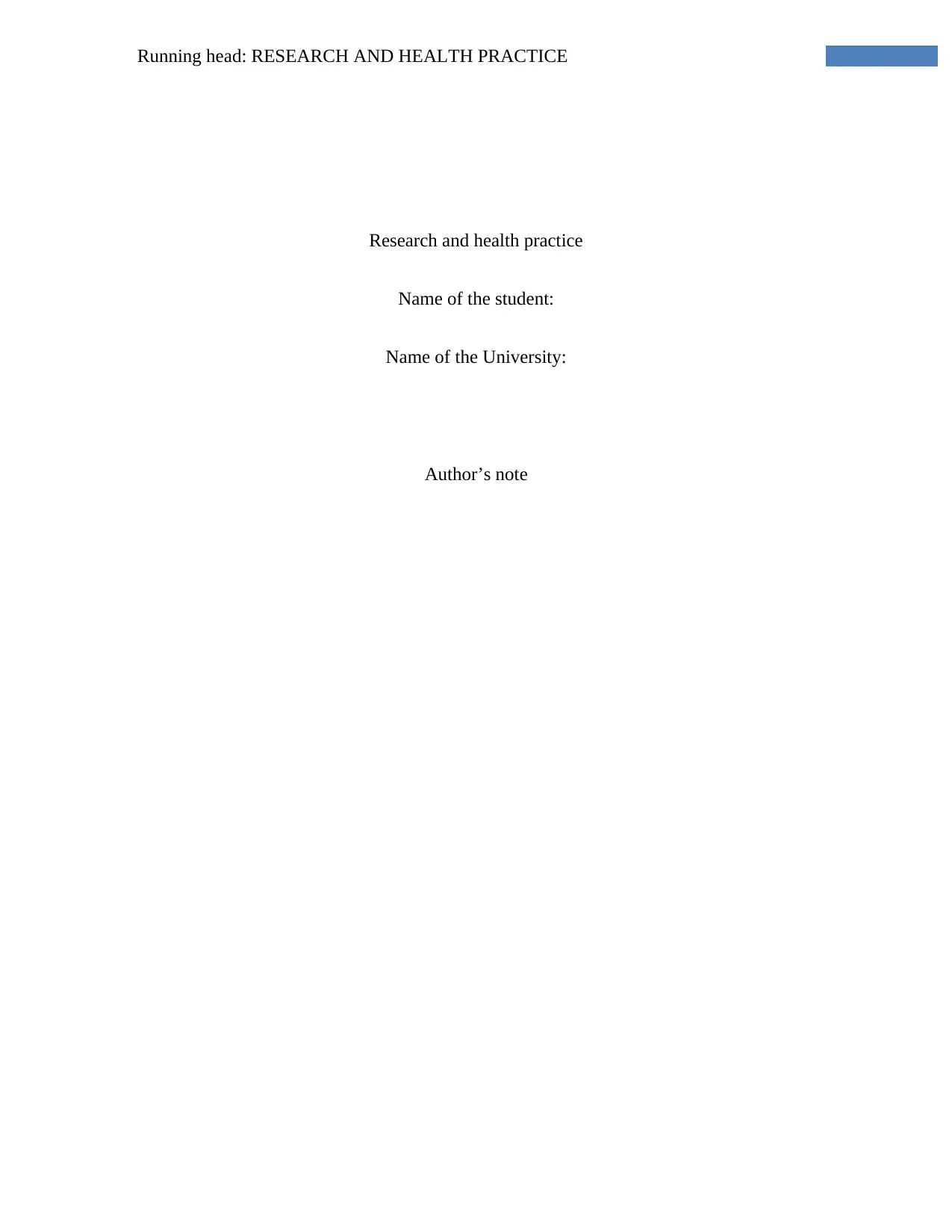
Running head: RESEARCH AND HEALTH PRACTICE
Research and health practice
Name of the student:
Name of the University:
Author’s note
Research and health practice
Name of the student:
Name of the University:
Author’s note
Paraphrase This Document
Need a fresh take? Get an instant paraphrase of this document with our AI Paraphraser
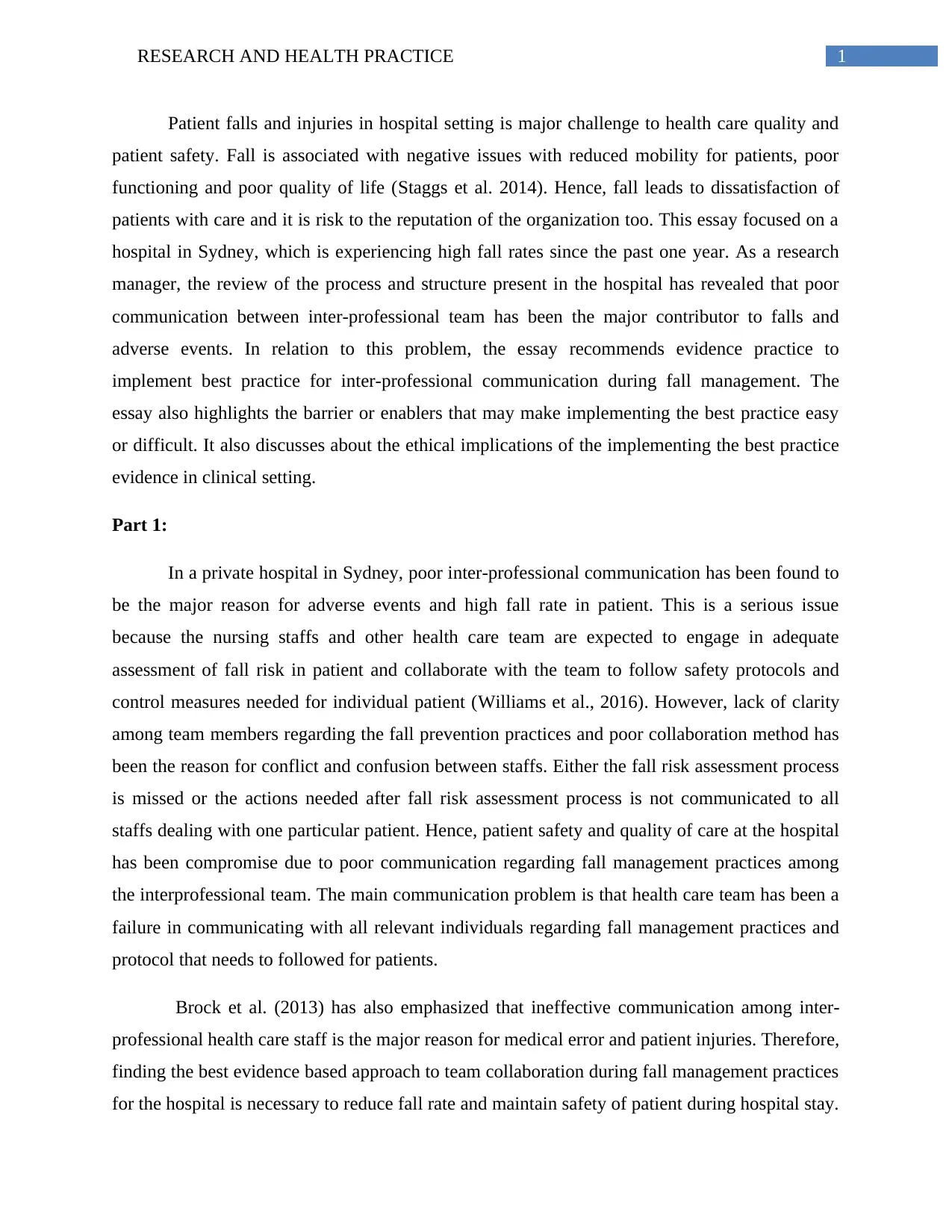
1RESEARCH AND HEALTH PRACTICE
Patient falls and injuries in hospital setting is major challenge to health care quality and
patient safety. Fall is associated with negative issues with reduced mobility for patients, poor
functioning and poor quality of life (Staggs et al. 2014). Hence, fall leads to dissatisfaction of
patients with care and it is risk to the reputation of the organization too. This essay focused on a
hospital in Sydney, which is experiencing high fall rates since the past one year. As a research
manager, the review of the process and structure present in the hospital has revealed that poor
communication between inter-professional team has been the major contributor to falls and
adverse events. In relation to this problem, the essay recommends evidence practice to
implement best practice for inter-professional communication during fall management. The
essay also highlights the barrier or enablers that may make implementing the best practice easy
or difficult. It also discusses about the ethical implications of the implementing the best practice
evidence in clinical setting.
Part 1:
In a private hospital in Sydney, poor inter-professional communication has been found to
be the major reason for adverse events and high fall rate in patient. This is a serious issue
because the nursing staffs and other health care team are expected to engage in adequate
assessment of fall risk in patient and collaborate with the team to follow safety protocols and
control measures needed for individual patient (Williams et al., 2016). However, lack of clarity
among team members regarding the fall prevention practices and poor collaboration method has
been the reason for conflict and confusion between staffs. Either the fall risk assessment process
is missed or the actions needed after fall risk assessment process is not communicated to all
staffs dealing with one particular patient. Hence, patient safety and quality of care at the hospital
has been compromise due to poor communication regarding fall management practices among
the interprofessional team. The main communication problem is that health care team has been a
failure in communicating with all relevant individuals regarding fall management practices and
protocol that needs to followed for patients.
Brock et al. (2013) has also emphasized that ineffective communication among inter-
professional health care staff is the major reason for medical error and patient injuries. Therefore,
finding the best evidence based approach to team collaboration during fall management practices
for the hospital is necessary to reduce fall rate and maintain safety of patient during hospital stay.
Patient falls and injuries in hospital setting is major challenge to health care quality and
patient safety. Fall is associated with negative issues with reduced mobility for patients, poor
functioning and poor quality of life (Staggs et al. 2014). Hence, fall leads to dissatisfaction of
patients with care and it is risk to the reputation of the organization too. This essay focused on a
hospital in Sydney, which is experiencing high fall rates since the past one year. As a research
manager, the review of the process and structure present in the hospital has revealed that poor
communication between inter-professional team has been the major contributor to falls and
adverse events. In relation to this problem, the essay recommends evidence practice to
implement best practice for inter-professional communication during fall management. The
essay also highlights the barrier or enablers that may make implementing the best practice easy
or difficult. It also discusses about the ethical implications of the implementing the best practice
evidence in clinical setting.
Part 1:
In a private hospital in Sydney, poor inter-professional communication has been found to
be the major reason for adverse events and high fall rate in patient. This is a serious issue
because the nursing staffs and other health care team are expected to engage in adequate
assessment of fall risk in patient and collaborate with the team to follow safety protocols and
control measures needed for individual patient (Williams et al., 2016). However, lack of clarity
among team members regarding the fall prevention practices and poor collaboration method has
been the reason for conflict and confusion between staffs. Either the fall risk assessment process
is missed or the actions needed after fall risk assessment process is not communicated to all
staffs dealing with one particular patient. Hence, patient safety and quality of care at the hospital
has been compromise due to poor communication regarding fall management practices among
the interprofessional team. The main communication problem is that health care team has been a
failure in communicating with all relevant individuals regarding fall management practices and
protocol that needs to followed for patients.
Brock et al. (2013) has also emphasized that ineffective communication among inter-
professional health care staff is the major reason for medical error and patient injuries. Therefore,
finding the best evidence based approach to team collaboration during fall management practices
for the hospital is necessary to reduce fall rate and maintain safety of patient during hospital stay.
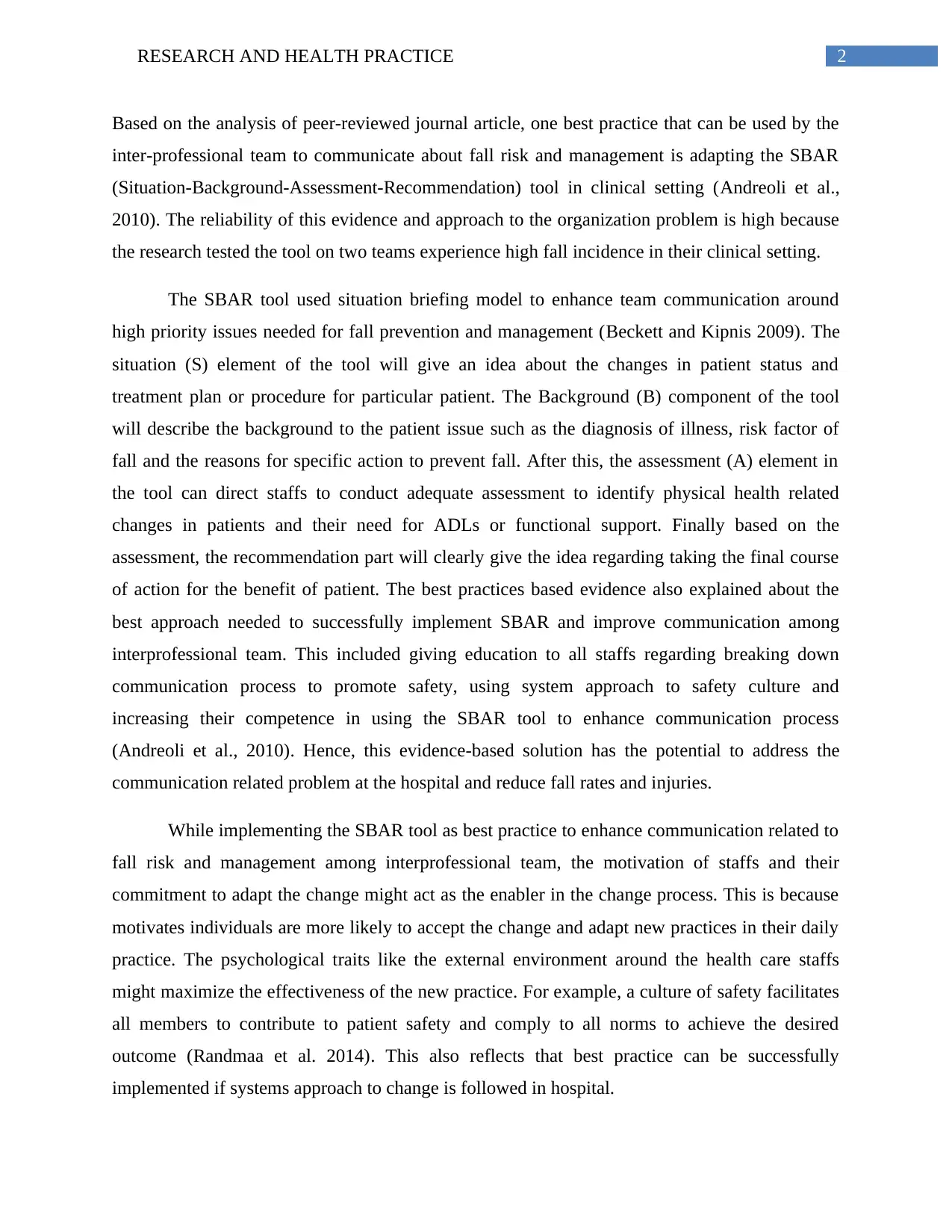
2RESEARCH AND HEALTH PRACTICE
Based on the analysis of peer-reviewed journal article, one best practice that can be used by the
inter-professional team to communicate about fall risk and management is adapting the SBAR
(Situation-Background-Assessment-Recommendation) tool in clinical setting (Andreoli et al.,
2010). The reliability of this evidence and approach to the organization problem is high because
the research tested the tool on two teams experience high fall incidence in their clinical setting.
The SBAR tool used situation briefing model to enhance team communication around
high priority issues needed for fall prevention and management (Beckett and Kipnis 2009). The
situation (S) element of the tool will give an idea about the changes in patient status and
treatment plan or procedure for particular patient. The Background (B) component of the tool
will describe the background to the patient issue such as the diagnosis of illness, risk factor of
fall and the reasons for specific action to prevent fall. After this, the assessment (A) element in
the tool can direct staffs to conduct adequate assessment to identify physical health related
changes in patients and their need for ADLs or functional support. Finally based on the
assessment, the recommendation part will clearly give the idea regarding taking the final course
of action for the benefit of patient. The best practices based evidence also explained about the
best approach needed to successfully implement SBAR and improve communication among
interprofessional team. This included giving education to all staffs regarding breaking down
communication process to promote safety, using system approach to safety culture and
increasing their competence in using the SBAR tool to enhance communication process
(Andreoli et al., 2010). Hence, this evidence-based solution has the potential to address the
communication related problem at the hospital and reduce fall rates and injuries.
While implementing the SBAR tool as best practice to enhance communication related to
fall risk and management among interprofessional team, the motivation of staffs and their
commitment to adapt the change might act as the enabler in the change process. This is because
motivates individuals are more likely to accept the change and adapt new practices in their daily
practice. The psychological traits like the external environment around the health care staffs
might maximize the effectiveness of the new practice. For example, a culture of safety facilitates
all members to contribute to patient safety and comply to all norms to achieve the desired
outcome (Randmaa et al. 2014). This also reflects that best practice can be successfully
implemented if systems approach to change is followed in hospital.
Based on the analysis of peer-reviewed journal article, one best practice that can be used by the
inter-professional team to communicate about fall risk and management is adapting the SBAR
(Situation-Background-Assessment-Recommendation) tool in clinical setting (Andreoli et al.,
2010). The reliability of this evidence and approach to the organization problem is high because
the research tested the tool on two teams experience high fall incidence in their clinical setting.
The SBAR tool used situation briefing model to enhance team communication around
high priority issues needed for fall prevention and management (Beckett and Kipnis 2009). The
situation (S) element of the tool will give an idea about the changes in patient status and
treatment plan or procedure for particular patient. The Background (B) component of the tool
will describe the background to the patient issue such as the diagnosis of illness, risk factor of
fall and the reasons for specific action to prevent fall. After this, the assessment (A) element in
the tool can direct staffs to conduct adequate assessment to identify physical health related
changes in patients and their need for ADLs or functional support. Finally based on the
assessment, the recommendation part will clearly give the idea regarding taking the final course
of action for the benefit of patient. The best practices based evidence also explained about the
best approach needed to successfully implement SBAR and improve communication among
interprofessional team. This included giving education to all staffs regarding breaking down
communication process to promote safety, using system approach to safety culture and
increasing their competence in using the SBAR tool to enhance communication process
(Andreoli et al., 2010). Hence, this evidence-based solution has the potential to address the
communication related problem at the hospital and reduce fall rates and injuries.
While implementing the SBAR tool as best practice to enhance communication related to
fall risk and management among interprofessional team, the motivation of staffs and their
commitment to adapt the change might act as the enabler in the change process. This is because
motivates individuals are more likely to accept the change and adapt new practices in their daily
practice. The psychological traits like the external environment around the health care staffs
might maximize the effectiveness of the new practice. For example, a culture of safety facilitates
all members to contribute to patient safety and comply to all norms to achieve the desired
outcome (Randmaa et al. 2014). This also reflects that best practice can be successfully
implemented if systems approach to change is followed in hospital.
⊘ This is a preview!⊘
Do you want full access?
Subscribe today to unlock all pages.

Trusted by 1+ million students worldwide
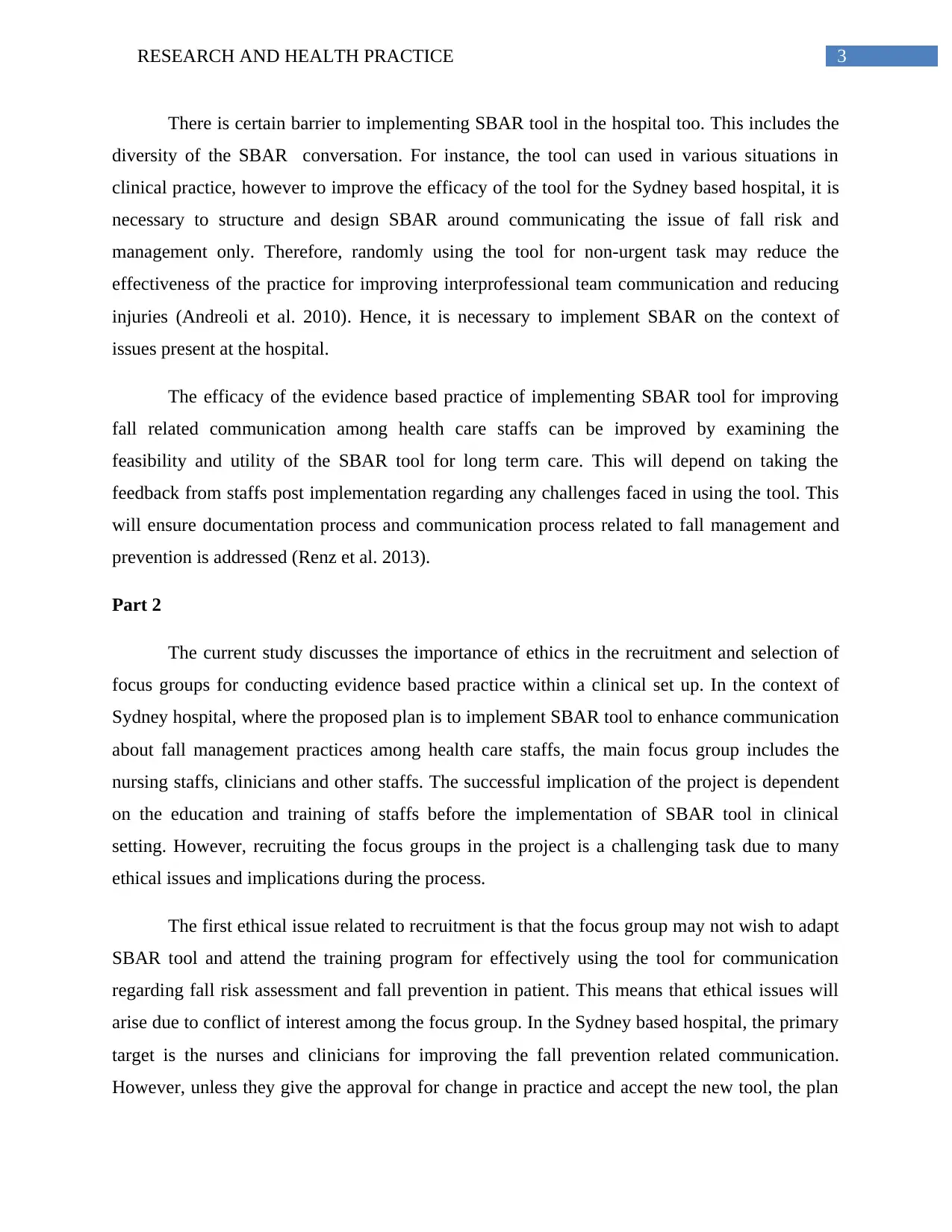
3RESEARCH AND HEALTH PRACTICE
There is certain barrier to implementing SBAR tool in the hospital too. This includes the
diversity of the SBAR conversation. For instance, the tool can used in various situations in
clinical practice, however to improve the efficacy of the tool for the Sydney based hospital, it is
necessary to structure and design SBAR around communicating the issue of fall risk and
management only. Therefore, randomly using the tool for non-urgent task may reduce the
effectiveness of the practice for improving interprofessional team communication and reducing
injuries (Andreoli et al. 2010). Hence, it is necessary to implement SBAR on the context of
issues present at the hospital.
The efficacy of the evidence based practice of implementing SBAR tool for improving
fall related communication among health care staffs can be improved by examining the
feasibility and utility of the SBAR tool for long term care. This will depend on taking the
feedback from staffs post implementation regarding any challenges faced in using the tool. This
will ensure documentation process and communication process related to fall management and
prevention is addressed (Renz et al. 2013).
Part 2
The current study discusses the importance of ethics in the recruitment and selection of
focus groups for conducting evidence based practice within a clinical set up. In the context of
Sydney hospital, where the proposed plan is to implement SBAR tool to enhance communication
about fall management practices among health care staffs, the main focus group includes the
nursing staffs, clinicians and other staffs. The successful implication of the project is dependent
on the education and training of staffs before the implementation of SBAR tool in clinical
setting. However, recruiting the focus groups in the project is a challenging task due to many
ethical issues and implications during the process.
The first ethical issue related to recruitment is that the focus group may not wish to adapt
SBAR tool and attend the training program for effectively using the tool for communication
regarding fall risk assessment and fall prevention in patient. This means that ethical issues will
arise due to conflict of interest among the focus group. In the Sydney based hospital, the primary
target is the nurses and clinicians for improving the fall prevention related communication.
However, unless they give the approval for change in practice and accept the new tool, the plan
There is certain barrier to implementing SBAR tool in the hospital too. This includes the
diversity of the SBAR conversation. For instance, the tool can used in various situations in
clinical practice, however to improve the efficacy of the tool for the Sydney based hospital, it is
necessary to structure and design SBAR around communicating the issue of fall risk and
management only. Therefore, randomly using the tool for non-urgent task may reduce the
effectiveness of the practice for improving interprofessional team communication and reducing
injuries (Andreoli et al. 2010). Hence, it is necessary to implement SBAR on the context of
issues present at the hospital.
The efficacy of the evidence based practice of implementing SBAR tool for improving
fall related communication among health care staffs can be improved by examining the
feasibility and utility of the SBAR tool for long term care. This will depend on taking the
feedback from staffs post implementation regarding any challenges faced in using the tool. This
will ensure documentation process and communication process related to fall management and
prevention is addressed (Renz et al. 2013).
Part 2
The current study discusses the importance of ethics in the recruitment and selection of
focus groups for conducting evidence based practice within a clinical set up. In the context of
Sydney hospital, where the proposed plan is to implement SBAR tool to enhance communication
about fall management practices among health care staffs, the main focus group includes the
nursing staffs, clinicians and other staffs. The successful implication of the project is dependent
on the education and training of staffs before the implementation of SBAR tool in clinical
setting. However, recruiting the focus groups in the project is a challenging task due to many
ethical issues and implications during the process.
The first ethical issue related to recruitment is that the focus group may not wish to adapt
SBAR tool and attend the training program for effectively using the tool for communication
regarding fall risk assessment and fall prevention in patient. This means that ethical issues will
arise due to conflict of interest among the focus group. In the Sydney based hospital, the primary
target is the nurses and clinicians for improving the fall prevention related communication.
However, unless they give the approval for change in practice and accept the new tool, the plan
Paraphrase This Document
Need a fresh take? Get an instant paraphrase of this document with our AI Paraphraser
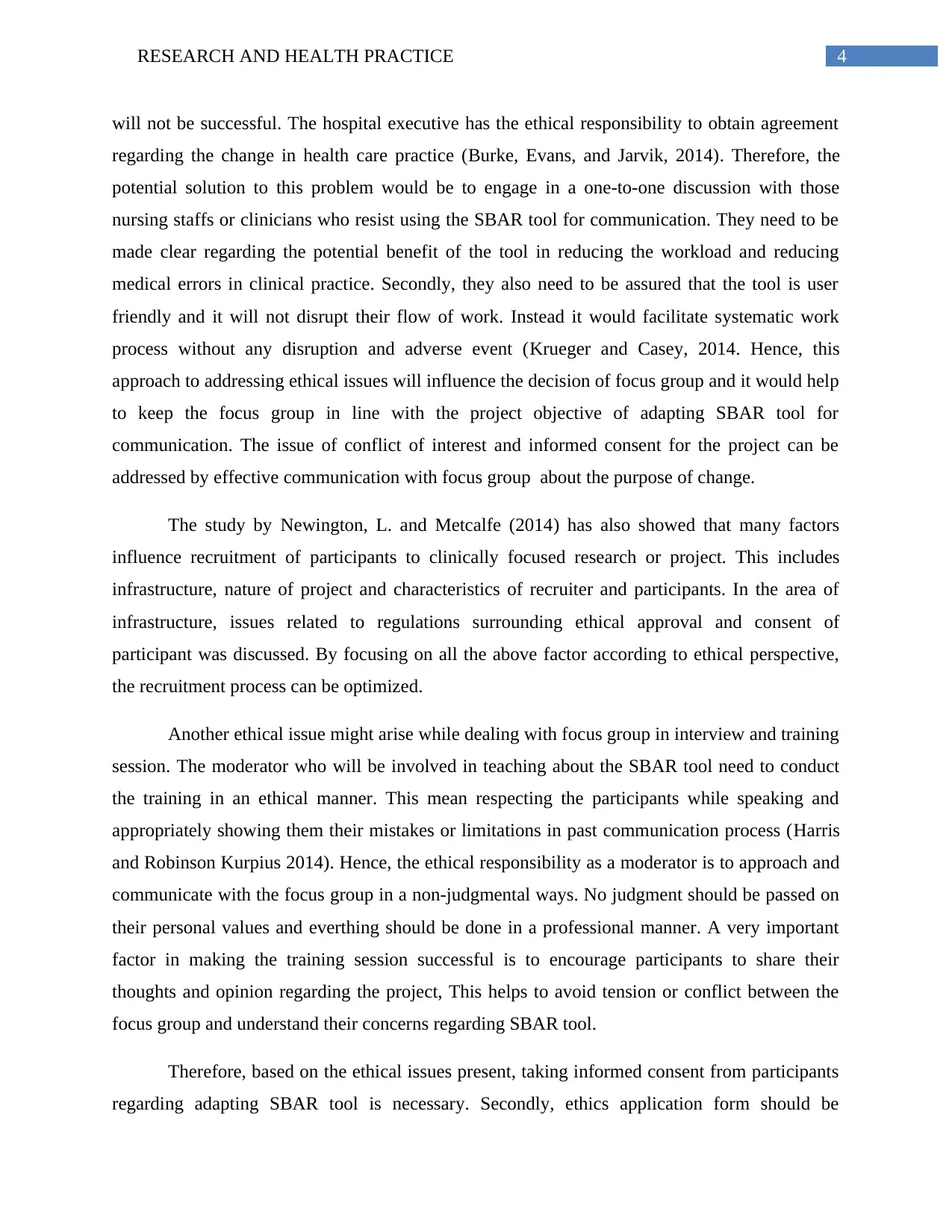
4RESEARCH AND HEALTH PRACTICE
will not be successful. The hospital executive has the ethical responsibility to obtain agreement
regarding the change in health care practice (Burke, Evans, and Jarvik, 2014). Therefore, the
potential solution to this problem would be to engage in a one-to-one discussion with those
nursing staffs or clinicians who resist using the SBAR tool for communication. They need to be
made clear regarding the potential benefit of the tool in reducing the workload and reducing
medical errors in clinical practice. Secondly, they also need to be assured that the tool is user
friendly and it will not disrupt their flow of work. Instead it would facilitate systematic work
process without any disruption and adverse event (Krueger and Casey, 2014. Hence, this
approach to addressing ethical issues will influence the decision of focus group and it would help
to keep the focus group in line with the project objective of adapting SBAR tool for
communication. The issue of conflict of interest and informed consent for the project can be
addressed by effective communication with focus group about the purpose of change.
The study by Newington, L. and Metcalfe (2014) has also showed that many factors
influence recruitment of participants to clinically focused research or project. This includes
infrastructure, nature of project and characteristics of recruiter and participants. In the area of
infrastructure, issues related to regulations surrounding ethical approval and consent of
participant was discussed. By focusing on all the above factor according to ethical perspective,
the recruitment process can be optimized.
Another ethical issue might arise while dealing with focus group in interview and training
session. The moderator who will be involved in teaching about the SBAR tool need to conduct
the training in an ethical manner. This mean respecting the participants while speaking and
appropriately showing them their mistakes or limitations in past communication process (Harris
and Robinson Kurpius 2014). Hence, the ethical responsibility as a moderator is to approach and
communicate with the focus group in a non-judgmental ways. No judgment should be passed on
their personal values and everthing should be done in a professional manner. A very important
factor in making the training session successful is to encourage participants to share their
thoughts and opinion regarding the project, This helps to avoid tension or conflict between the
focus group and understand their concerns regarding SBAR tool.
Therefore, based on the ethical issues present, taking informed consent from participants
regarding adapting SBAR tool is necessary. Secondly, ethics application form should be
will not be successful. The hospital executive has the ethical responsibility to obtain agreement
regarding the change in health care practice (Burke, Evans, and Jarvik, 2014). Therefore, the
potential solution to this problem would be to engage in a one-to-one discussion with those
nursing staffs or clinicians who resist using the SBAR tool for communication. They need to be
made clear regarding the potential benefit of the tool in reducing the workload and reducing
medical errors in clinical practice. Secondly, they also need to be assured that the tool is user
friendly and it will not disrupt their flow of work. Instead it would facilitate systematic work
process without any disruption and adverse event (Krueger and Casey, 2014. Hence, this
approach to addressing ethical issues will influence the decision of focus group and it would help
to keep the focus group in line with the project objective of adapting SBAR tool for
communication. The issue of conflict of interest and informed consent for the project can be
addressed by effective communication with focus group about the purpose of change.
The study by Newington, L. and Metcalfe (2014) has also showed that many factors
influence recruitment of participants to clinically focused research or project. This includes
infrastructure, nature of project and characteristics of recruiter and participants. In the area of
infrastructure, issues related to regulations surrounding ethical approval and consent of
participant was discussed. By focusing on all the above factor according to ethical perspective,
the recruitment process can be optimized.
Another ethical issue might arise while dealing with focus group in interview and training
session. The moderator who will be involved in teaching about the SBAR tool need to conduct
the training in an ethical manner. This mean respecting the participants while speaking and
appropriately showing them their mistakes or limitations in past communication process (Harris
and Robinson Kurpius 2014). Hence, the ethical responsibility as a moderator is to approach and
communicate with the focus group in a non-judgmental ways. No judgment should be passed on
their personal values and everthing should be done in a professional manner. A very important
factor in making the training session successful is to encourage participants to share their
thoughts and opinion regarding the project, This helps to avoid tension or conflict between the
focus group and understand their concerns regarding SBAR tool.
Therefore, based on the ethical issues present, taking informed consent from participants
regarding adapting SBAR tool is necessary. Secondly, ethics application form should be
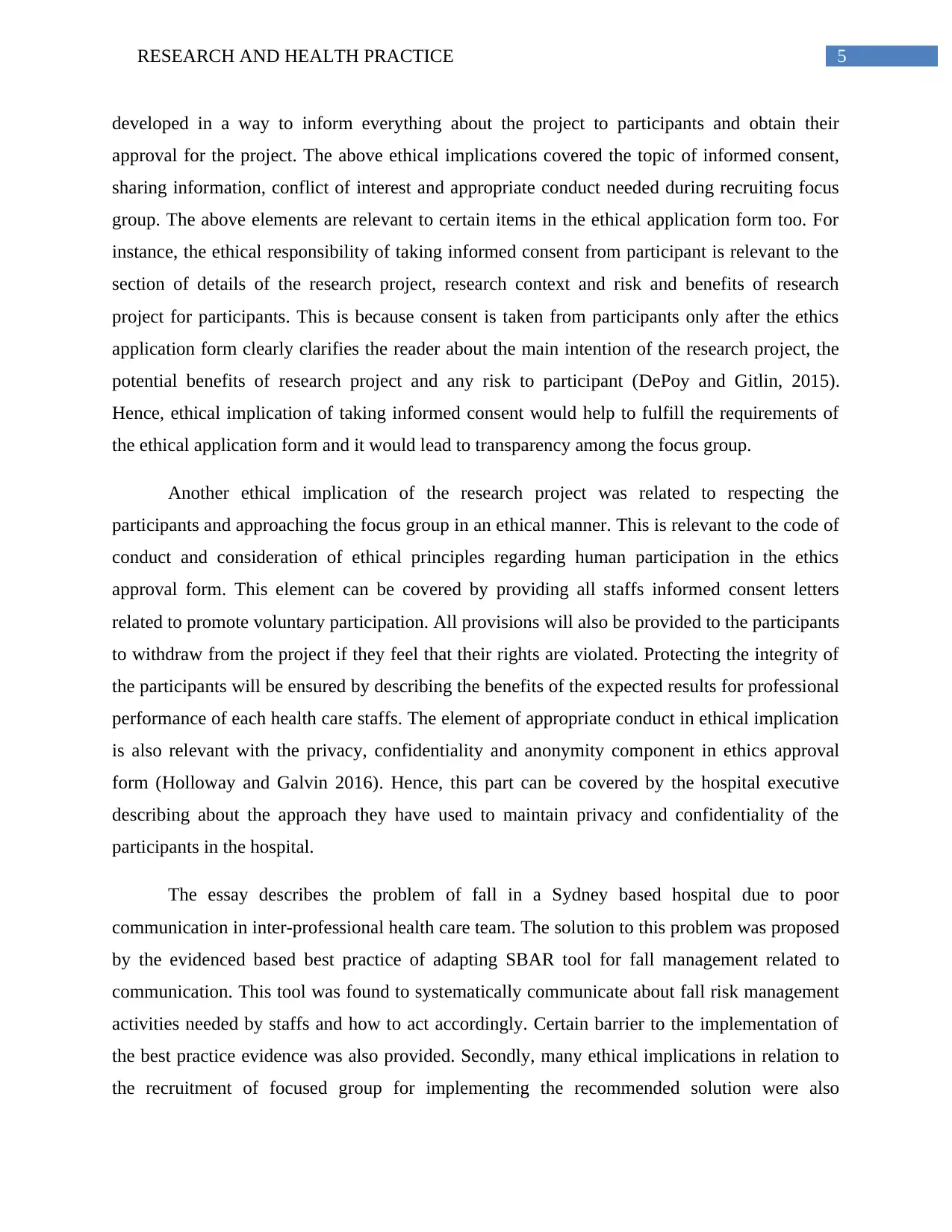
5RESEARCH AND HEALTH PRACTICE
developed in a way to inform everything about the project to participants and obtain their
approval for the project. The above ethical implications covered the topic of informed consent,
sharing information, conflict of interest and appropriate conduct needed during recruiting focus
group. The above elements are relevant to certain items in the ethical application form too. For
instance, the ethical responsibility of taking informed consent from participant is relevant to the
section of details of the research project, research context and risk and benefits of research
project for participants. This is because consent is taken from participants only after the ethics
application form clearly clarifies the reader about the main intention of the research project, the
potential benefits of research project and any risk to participant (DePoy and Gitlin, 2015).
Hence, ethical implication of taking informed consent would help to fulfill the requirements of
the ethical application form and it would lead to transparency among the focus group.
Another ethical implication of the research project was related to respecting the
participants and approaching the focus group in an ethical manner. This is relevant to the code of
conduct and consideration of ethical principles regarding human participation in the ethics
approval form. This element can be covered by providing all staffs informed consent letters
related to promote voluntary participation. All provisions will also be provided to the participants
to withdraw from the project if they feel that their rights are violated. Protecting the integrity of
the participants will be ensured by describing the benefits of the expected results for professional
performance of each health care staffs. The element of appropriate conduct in ethical implication
is also relevant with the privacy, confidentiality and anonymity component in ethics approval
form (Holloway and Galvin 2016). Hence, this part can be covered by the hospital executive
describing about the approach they have used to maintain privacy and confidentiality of the
participants in the hospital.
The essay describes the problem of fall in a Sydney based hospital due to poor
communication in inter-professional health care team. The solution to this problem was proposed
by the evidenced based best practice of adapting SBAR tool for fall management related to
communication. This tool was found to systematically communicate about fall risk management
activities needed by staffs and how to act accordingly. Certain barrier to the implementation of
the best practice evidence was also provided. Secondly, many ethical implications in relation to
the recruitment of focused group for implementing the recommended solution were also
developed in a way to inform everything about the project to participants and obtain their
approval for the project. The above ethical implications covered the topic of informed consent,
sharing information, conflict of interest and appropriate conduct needed during recruiting focus
group. The above elements are relevant to certain items in the ethical application form too. For
instance, the ethical responsibility of taking informed consent from participant is relevant to the
section of details of the research project, research context and risk and benefits of research
project for participants. This is because consent is taken from participants only after the ethics
application form clearly clarifies the reader about the main intention of the research project, the
potential benefits of research project and any risk to participant (DePoy and Gitlin, 2015).
Hence, ethical implication of taking informed consent would help to fulfill the requirements of
the ethical application form and it would lead to transparency among the focus group.
Another ethical implication of the research project was related to respecting the
participants and approaching the focus group in an ethical manner. This is relevant to the code of
conduct and consideration of ethical principles regarding human participation in the ethics
approval form. This element can be covered by providing all staffs informed consent letters
related to promote voluntary participation. All provisions will also be provided to the participants
to withdraw from the project if they feel that their rights are violated. Protecting the integrity of
the participants will be ensured by describing the benefits of the expected results for professional
performance of each health care staffs. The element of appropriate conduct in ethical implication
is also relevant with the privacy, confidentiality and anonymity component in ethics approval
form (Holloway and Galvin 2016). Hence, this part can be covered by the hospital executive
describing about the approach they have used to maintain privacy and confidentiality of the
participants in the hospital.
The essay describes the problem of fall in a Sydney based hospital due to poor
communication in inter-professional health care team. The solution to this problem was proposed
by the evidenced based best practice of adapting SBAR tool for fall management related to
communication. This tool was found to systematically communicate about fall risk management
activities needed by staffs and how to act accordingly. Certain barrier to the implementation of
the best practice evidence was also provided. Secondly, many ethical implications in relation to
the recruitment of focused group for implementing the recommended solution were also
⊘ This is a preview!⊘
Do you want full access?
Subscribe today to unlock all pages.

Trusted by 1+ million students worldwide
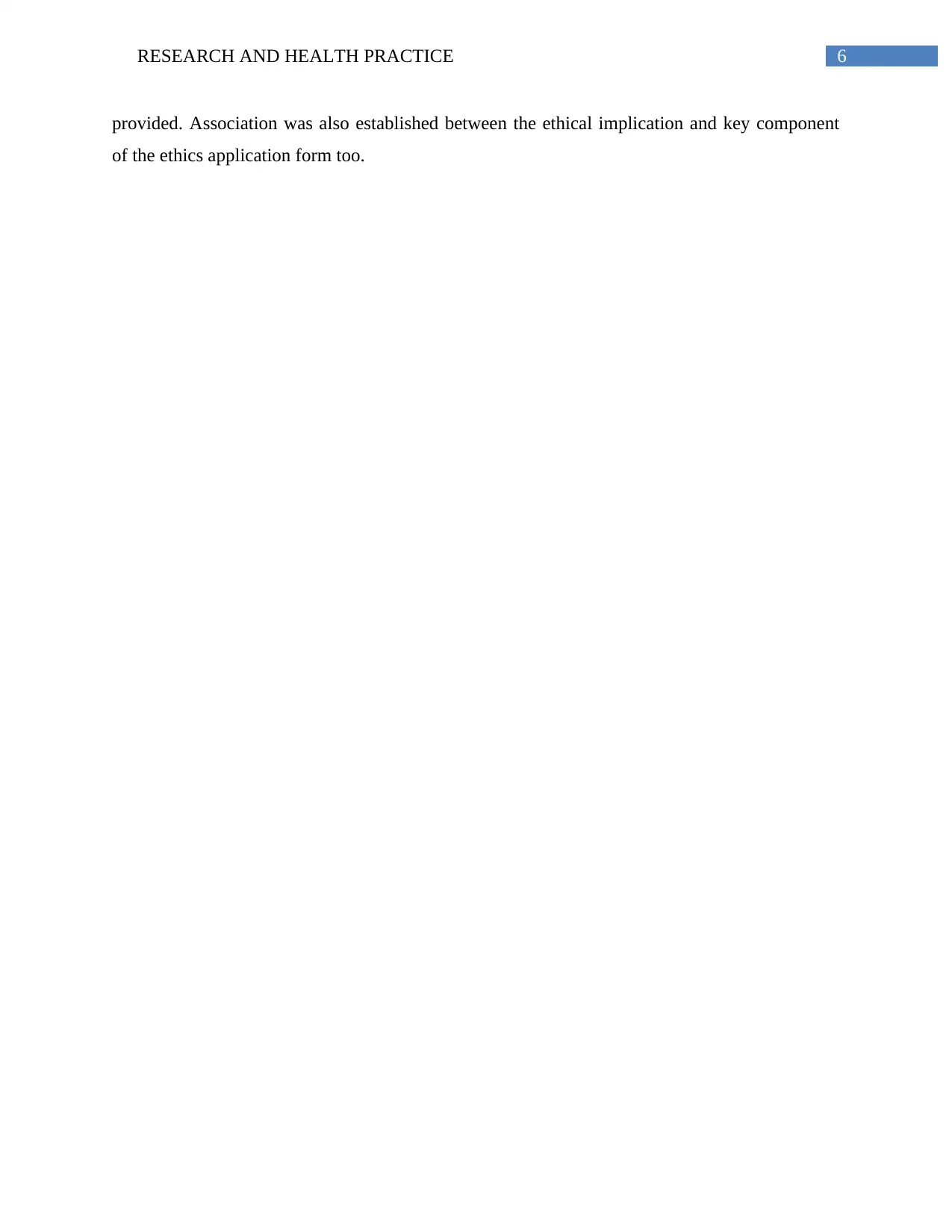
6RESEARCH AND HEALTH PRACTICE
provided. Association was also established between the ethical implication and key component
of the ethics application form too.
provided. Association was also established between the ethical implication and key component
of the ethics application form too.
Paraphrase This Document
Need a fresh take? Get an instant paraphrase of this document with our AI Paraphraser
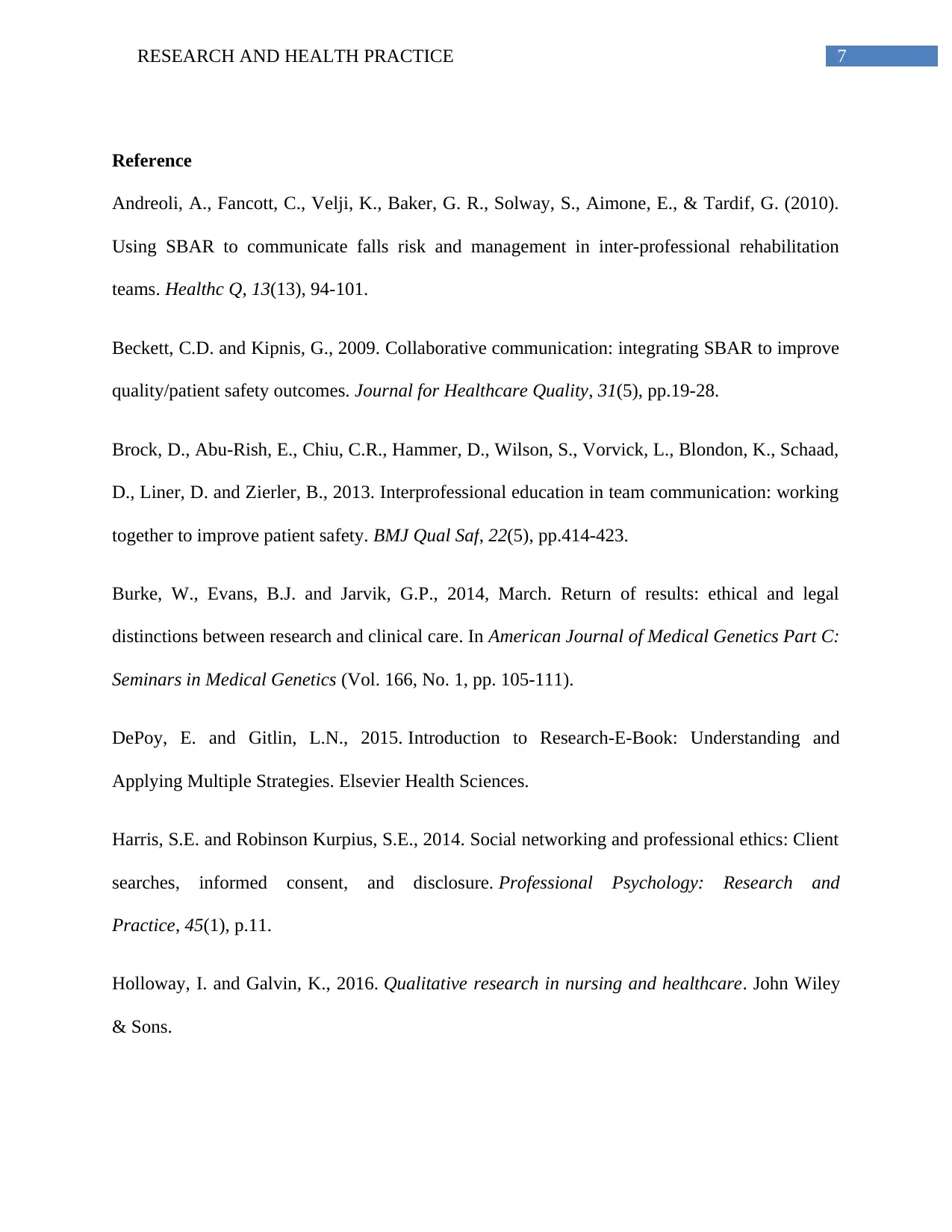
7RESEARCH AND HEALTH PRACTICE
Reference
Andreoli, A., Fancott, C., Velji, K., Baker, G. R., Solway, S., Aimone, E., & Tardif, G. (2010).
Using SBAR to communicate falls risk and management in inter-professional rehabilitation
teams. Healthc Q, 13(13), 94-101.
Beckett, C.D. and Kipnis, G., 2009. Collaborative communication: integrating SBAR to improve
quality/patient safety outcomes. Journal for Healthcare Quality, 31(5), pp.19-28.
Brock, D., Abu-Rish, E., Chiu, C.R., Hammer, D., Wilson, S., Vorvick, L., Blondon, K., Schaad,
D., Liner, D. and Zierler, B., 2013. Interprofessional education in team communication: working
together to improve patient safety. BMJ Qual Saf, 22(5), pp.414-423.
Burke, W., Evans, B.J. and Jarvik, G.P., 2014, March. Return of results: ethical and legal
distinctions between research and clinical care. In American Journal of Medical Genetics Part C:
Seminars in Medical Genetics (Vol. 166, No. 1, pp. 105-111).
DePoy, E. and Gitlin, L.N., 2015. Introduction to Research-E-Book: Understanding and
Applying Multiple Strategies. Elsevier Health Sciences.
Harris, S.E. and Robinson Kurpius, S.E., 2014. Social networking and professional ethics: Client
searches, informed consent, and disclosure. Professional Psychology: Research and
Practice, 45(1), p.11.
Holloway, I. and Galvin, K., 2016. Qualitative research in nursing and healthcare. John Wiley
& Sons.
Reference
Andreoli, A., Fancott, C., Velji, K., Baker, G. R., Solway, S., Aimone, E., & Tardif, G. (2010).
Using SBAR to communicate falls risk and management in inter-professional rehabilitation
teams. Healthc Q, 13(13), 94-101.
Beckett, C.D. and Kipnis, G., 2009. Collaborative communication: integrating SBAR to improve
quality/patient safety outcomes. Journal for Healthcare Quality, 31(5), pp.19-28.
Brock, D., Abu-Rish, E., Chiu, C.R., Hammer, D., Wilson, S., Vorvick, L., Blondon, K., Schaad,
D., Liner, D. and Zierler, B., 2013. Interprofessional education in team communication: working
together to improve patient safety. BMJ Qual Saf, 22(5), pp.414-423.
Burke, W., Evans, B.J. and Jarvik, G.P., 2014, March. Return of results: ethical and legal
distinctions between research and clinical care. In American Journal of Medical Genetics Part C:
Seminars in Medical Genetics (Vol. 166, No. 1, pp. 105-111).
DePoy, E. and Gitlin, L.N., 2015. Introduction to Research-E-Book: Understanding and
Applying Multiple Strategies. Elsevier Health Sciences.
Harris, S.E. and Robinson Kurpius, S.E., 2014. Social networking and professional ethics: Client
searches, informed consent, and disclosure. Professional Psychology: Research and
Practice, 45(1), p.11.
Holloway, I. and Galvin, K., 2016. Qualitative research in nursing and healthcare. John Wiley
& Sons.
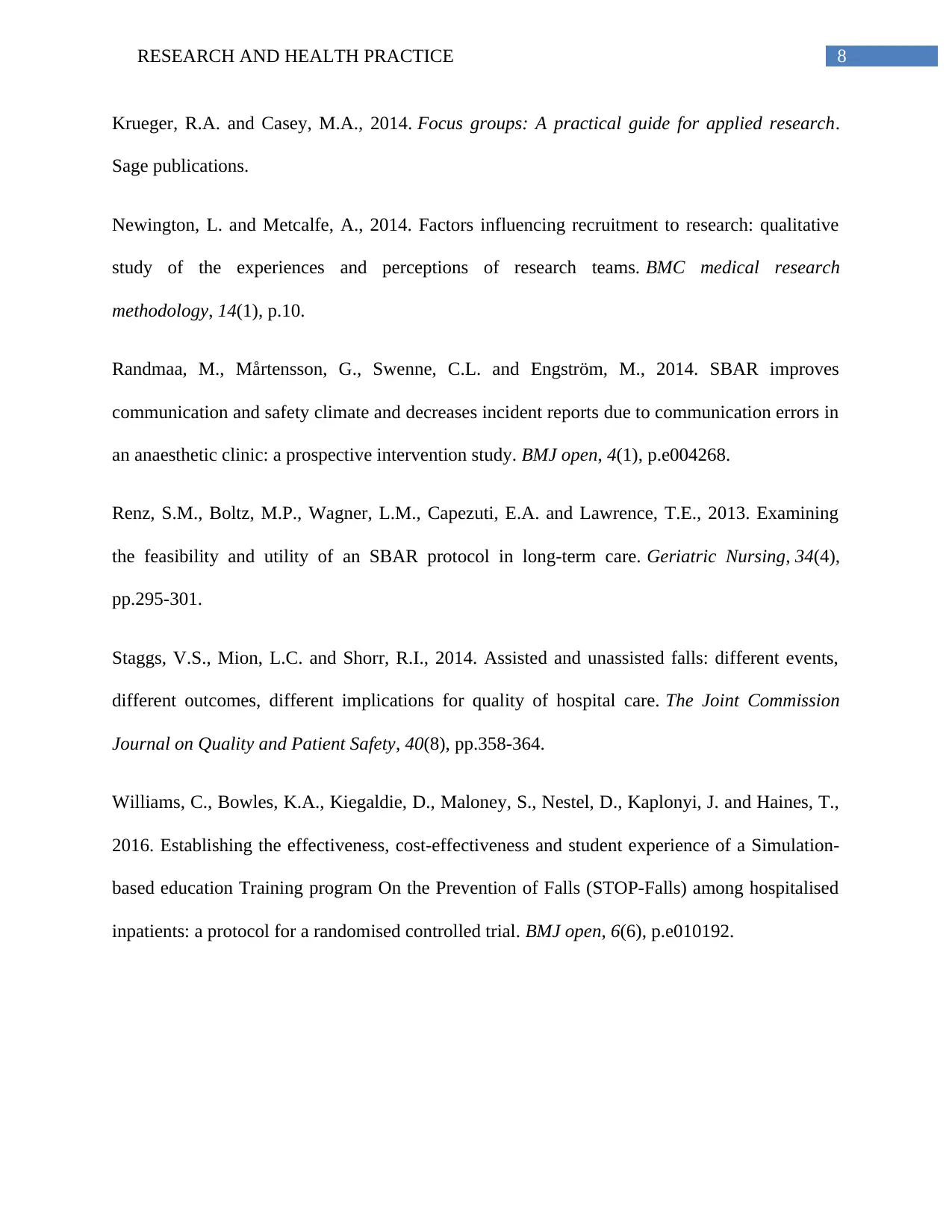
8RESEARCH AND HEALTH PRACTICE
Krueger, R.A. and Casey, M.A., 2014. Focus groups: A practical guide for applied research.
Sage publications.
Newington, L. and Metcalfe, A., 2014. Factors influencing recruitment to research: qualitative
study of the experiences and perceptions of research teams. BMC medical research
methodology, 14(1), p.10.
Randmaa, M., Mårtensson, G., Swenne, C.L. and Engström, M., 2014. SBAR improves
communication and safety climate and decreases incident reports due to communication errors in
an anaesthetic clinic: a prospective intervention study. BMJ open, 4(1), p.e004268.
Renz, S.M., Boltz, M.P., Wagner, L.M., Capezuti, E.A. and Lawrence, T.E., 2013. Examining
the feasibility and utility of an SBAR protocol in long-term care. Geriatric Nursing, 34(4),
pp.295-301.
Staggs, V.S., Mion, L.C. and Shorr, R.I., 2014. Assisted and unassisted falls: different events,
different outcomes, different implications for quality of hospital care. The Joint Commission
Journal on Quality and Patient Safety, 40(8), pp.358-364.
Williams, C., Bowles, K.A., Kiegaldie, D., Maloney, S., Nestel, D., Kaplonyi, J. and Haines, T.,
2016. Establishing the effectiveness, cost-effectiveness and student experience of a Simulation-
based education Training program On the Prevention of Falls (STOP-Falls) among hospitalised
inpatients: a protocol for a randomised controlled trial. BMJ open, 6(6), p.e010192.
Krueger, R.A. and Casey, M.A., 2014. Focus groups: A practical guide for applied research.
Sage publications.
Newington, L. and Metcalfe, A., 2014. Factors influencing recruitment to research: qualitative
study of the experiences and perceptions of research teams. BMC medical research
methodology, 14(1), p.10.
Randmaa, M., Mårtensson, G., Swenne, C.L. and Engström, M., 2014. SBAR improves
communication and safety climate and decreases incident reports due to communication errors in
an anaesthetic clinic: a prospective intervention study. BMJ open, 4(1), p.e004268.
Renz, S.M., Boltz, M.P., Wagner, L.M., Capezuti, E.A. and Lawrence, T.E., 2013. Examining
the feasibility and utility of an SBAR protocol in long-term care. Geriatric Nursing, 34(4),
pp.295-301.
Staggs, V.S., Mion, L.C. and Shorr, R.I., 2014. Assisted and unassisted falls: different events,
different outcomes, different implications for quality of hospital care. The Joint Commission
Journal on Quality and Patient Safety, 40(8), pp.358-364.
Williams, C., Bowles, K.A., Kiegaldie, D., Maloney, S., Nestel, D., Kaplonyi, J. and Haines, T.,
2016. Establishing the effectiveness, cost-effectiveness and student experience of a Simulation-
based education Training program On the Prevention of Falls (STOP-Falls) among hospitalised
inpatients: a protocol for a randomised controlled trial. BMJ open, 6(6), p.e010192.
⊘ This is a preview!⊘
Do you want full access?
Subscribe today to unlock all pages.

Trusted by 1+ million students worldwide
1 out of 9
Related Documents
Your All-in-One AI-Powered Toolkit for Academic Success.
+13062052269
info@desklib.com
Available 24*7 on WhatsApp / Email
![[object Object]](/_next/static/media/star-bottom.7253800d.svg)
Unlock your academic potential
Copyright © 2020–2025 A2Z Services. All Rights Reserved. Developed and managed by ZUCOL.





